

Bit.ly. Lego and Class. Lego and Sexuality. Lego and Race. The Official, Animated History Of LEGO. History of Lego. Early Lego wood models from the 1930s The History of Lego spans almost 100 years of the existence of a toy that grew from small wooden playthings in the early 20th century into the center of a vast market of plastic building bricks that dominated the world markets for decades.

It is one of the oldest plastic toys in the world. Its manufacturing was started in Denmark, but was eventually replaced by factories throughout the world. Today it is one of the most successful toys and has remained an iconic brand with a loyal and continuing following. The traditional date for the first Lego blocks is 1947, and the toys have continued to be produced with little interruption since around that time.
Beginnings[edit] The Lego Group began in the carpentry workshop of Ole Kirk Christiansen, in Billund, Denmark. In 1932, Ole Kirk's shop started making wooden toys such as piggy banks, pull toys, cars and trucks and houses. Change to plastic bricks[edit] About Us The LEGO Group - The name 'LEGO' is an abbreviation of the two Danish words "leg godt", meaning "play well".
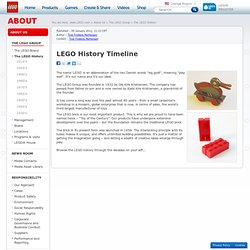
It’s our name and it’s our ideal. The LEGO Group was founded in 1932 by Ole Kirk Kristiansen. The company has passed from father to son and is now owned by Kjeld Kirk Kristiansen, a grandchild of the founder. It has come a long way over the past almost 80 years - from a small carpenter’s workshop to a modern, global enterprise that is now, in terms of sales, the world’s third-largest manufacturer of toys. Why Legos Are So Expensive — And So Popular : Planet Money. Notes Lego is crushing Mega Bloks, a rival that sells cheaper blocks. I went to Toys R Us recently to buy my son a Lego set for Hanukkah. Did you know a small box of Legos costs $60? Sixty bucks for 102 plastic blocks! In fact, I learned, Lego sets can sell for thousands of dollars. Luke, a 9-year-old Lego expert, set me straight. "They pay attention to so much detail," he said.
Lego goes to great lengths to make its pieces really, really well, says David Robertson, who is working on a book about Lego. Lego and Gender. Part I: Historical Perspective on the LEGO Gender Gap. Part II: Historical Perspective on the LEGO Gender Gap. The splashy introduction of the new LEGO friends line earlier this year stirred up a lot of controversy.

My goal with this set of posts is to provide some historical perspective for the valid concerns raised in this heated debate. 1989-2003: Gender Ahoy! I discussed the introduction of LEGOs the invention of gendered minifigs, and early efforts to market separately to girls and boys in Part I of this series, covering 1932 to 1988. Part III: Historical Perspective on the LEGO Gender Gap. The splashy introduction of the new LEGO friends line earlier this year stirred up a lot of controversy.
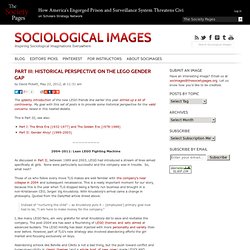
My goal with this set of posts is to provide some historical perspective for the valid concerns raised in this heated debate. This is Part III, see also: 2004-2011: Lean LEGO Fighting Machine As discussed in Part II, between 1989 and 2003, LEGO had introduced a stream of lines aimed specifically at girls. None were particularly successful and the company was in trouble. Those of us who follow every move TLG makes are well familiar with the company’s near collapse in 2004 and subsequent renaissance. Part IV: Historical Perspective on the LEGO Gender Gap. The splashy introduction of the new LEGO friends line earlier this year stirred up a lot of controversy.
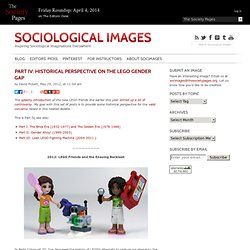
My goal with this set of posts is to provide some historical perspective for the valid concerns raised in this heated debate. This is Part IV, see also: 2012: LEGO Friends and the Ensuing Backlash In Parts I through III, I’ve discussed the history of LEGO’s attempts to capture (or abandon) the imagination of girls and boys. In this final installment, I discuss their newest effort to market to girls, LEGO Friends.
Several weeks before the first wave of LEGO Friends sets were available in U.S. retail stores, Bloomberg Businessweek ran a cover story that presented an in-depth look at TLG’s thought process in creating the sets. This move implies that they foresaw the backlash this line would inspire and hoped to mitigate it. In many ways, LEGO Friends is an improvement over the previous “girls only” themes. TLG seems to fundamentally misunderstand this argument. Lego. With New Toys, Lego Hopes To Build Girls Market.
Hide captionThe new Lego Friends toys are not yet public, but the company gave a sneak peek at its "Olivia" minifigure from the set.

Courtesy of Bloomberg Businessweek. Photographed by Nick Ferrari. Does Stripping Gender From Toys Really Make Sense? Lego Is for Girls. Walk into one of Lego’s 74 red-and-yellow retail stores around the world, or even down the toy aisles of your local Target (TGT), and two things are immediately clear: Lego, the Danish maker of plastic toy bricks, is everywhere, and it’s not for everybody.
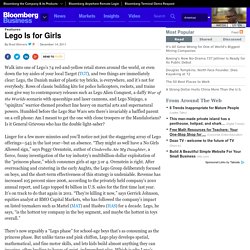
Rows of classic building kits for police helicopters, rockets, and trains soon give way to contemporary releases such as Lego Alien Conquest, a daffy War of the Worlds scenario with spaceships and laser cannons, and Lego Ninjago, a “spinjitzu” warrior-themed product line heavy on martial arts and supernatural powers.
Lego Has a Gender Problem - Design. One big difference between the Lego blocks that I grew up playing with and the Lego toys the company sells today: My Lego bricks never yelled anything at anyone, much less catcalled women on the street. Josh Stearns, the public media campaign director for the Free Press , found a set of stickers featuring Lego construction workers. The stickers depict Lego construction workers doing Lego construction worker stuff, including operating heavy equipment, using a jackhammer, and street-harassing women.
Pink Lego is an abomination. End this gender fascism. Take a look at the picture above.
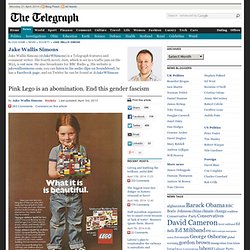
This is a Lego advertisement from the early Eighties, which has recently been circulating online. Beautiful, isn't it? A cheeky-looking child wearing scruffy child's clothes, proudly clutching a Lego creation which would resist any attempt at interpretation by an adult. The fact that the child happens to be a girl is neither here nor there. In case it's too small to be legible, the first paragraph of copy reads as follows: "Have you ever seen anything like it?
Contrast this with Lego Friends, the new range of Lego aimed specifically at girls, which celebrates its first birthday this year. To bring the contrast into sharper relief, it may be necessary – apologies in advance – to watch the Lego Friends advertisement below. Viewed as an isolated occurrence, this may not seem so bad. The HTML5 Gendered LEGO Advertising Remixer.
LEGO & Gender Part 1: Lego Friends. LEGO announced that after 4 years of intensive research, they have finally come up with a LEGO product that fulfills the desires of “how girls naturally build and play.”
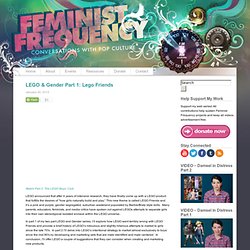
This new theme is called LEGO Friends and it’s a pink and purple, gender segregated, suburban wasteland populated by Barbie/Bratz style dolls. Many parents, educators, feminists, and media critics have spoken out against LEGOs attempts to separate girls into their own stereotypical isolated enclave within the LEGO universe. LEGO & Gender Part 2: The Boys Club. In part 1 of my two part LEGO and Gender series, I explored how LEGO went terribly wrong with LEGO Friends and provided a brief history of LEGO’s ridiculous and slightly hilarious attempts to market to girls since the late 70′s.

In part 2, I delve into how LEGO shifted their products from their initial relatively, gender neutral building experience to a more male dominated and male identified one. The LEGO group intentionally did this in three ways: 1. Marketing exclusively to boys, 2. Producing male identified and centered themes and sets and 3. Focusing on stereotypical boys play scenarios with an emphasis on combat. Lego & Gender : lego. The LEGO Gender Gap: A Historical Perspective. “Why does all the girls have to buy pink stuff?” Even a child can see something is wrong in our toy stores. The gender gap* that frustrates Riley in the above video does more than tell her which toys it socially appropriate for her to play with, it separates her from a whole realm of experience - masculinity. As Riley grows older and decides what sort of person she wants to be, she will encounter this gap again and again.